Polarization-Independent Ultra-Wideband Metamaterial Absorber for Solar Harvesting at Infrared Regime
Abstract
1. Introduction
2. Design and Simulation Setup
3. Results and Analysis
3.1. Absorption Characteristics
3.2. Polarization Independence and Angular Stabiltiy
3.3. Dependence on Geometric Parmeters
3.4. Mechanism of Absorption
4. Conclusions
Author Contributions
Funding
Conflicts of Interest
References
- Cui, T.J.; Smith, D.; Liu, R. (Eds.) Metamaterials; Springer: Boston, MA, USA, 2010; ISBN 978-1-4419-0572-7. [Google Scholar]
- Ghafari, S.; Forouzeshfard, M.R.; Vafapour, Z. Thermo Optical Switching and Sensing Applications of an Infrared Metamaterial. IEEE Sens. J. 2020, 20, 3235–3241. [Google Scholar] [CrossRef]
- Hoque, A.; Tariqul Islam, M.; Almutairi, A.; Alam, T.; Jit Singh, M.; Amin, N. A Polarization Independent Quasi-TEM Metamaterial Absorber for X and Ku Band Sensing Applications. Sensors 2018, 18, 4209. [Google Scholar] [CrossRef] [PubMed]
- Lari, E.S.; Vafapour, Z.; Ghahraloud, H. Optically tunable triple–band perfect absorber for nonlinear optical liquids sensing. IEEE Sens. J. 2020. [Google Scholar] [CrossRef]
- Hossain, M.J.; Karmaker, A.K.; Islam, M.J.; Ahmed, M.R.; Foysol, K.M. Polarization-Independent Perfect Metamaterial Absorber and Sensor Applications. DUET J. 2019, 5, 77–85. [Google Scholar]
- Vafapour, Z. Polarization-Independent Perfect Optical Metamaterial Absorber as a Glucose Sensor in Food Industry Applications. IEEE Trans. Nanobiosci. 2019, 18, 622–627. [Google Scholar] [CrossRef] [PubMed]
- Faruque, M.R.I.; Hossain, M.J.; Islam, S.S.; Jamlos, M.F.B.; Islam, M.T. Design and analysis of a new double C-shaped miniaturized metamaterial for multiband applications. Appl. Phys. A 2017, 123, 310. [Google Scholar] [CrossRef]
- Islam, S.S.; Faruque, M.R.I.; Islam, M.T. A new double negative metamaterial for multi-band microwave applications. Appl. Phys. A 2014, 116, 723–733. [Google Scholar] [CrossRef]
- Islam, S.S.; Tamim, A.M.; Faruque, M.R.I. A New Double-Negative Material for Multi-band Satellite Applications. In 10th International Conference on Robotics, Vision, Signal Processing and Power Applications; Zawawi, M.A.M., Teoh, S.S., Abdullah, N.B., Mohd Sazali, M.I.S., Eds.; Springer: Singapore, 2019; Volume 547, pp. 357–364. ISBN 9789811364464. [Google Scholar]
- Islam, S.S.; Hasan, M.M.; Faruque, M.R.I. A new metamaterial-based wideband rectangular invisibility cloak. Appl. Phys. A 2018, 124, 160. [Google Scholar] [CrossRef]
- Sunbeam Islam, S.; Rashed Iqbal Faruque, M.; Tariqul Islam, M. An ENG metamaterial based wideband electromagnetic cloak. Microw. Opt. Technol. Lett. 2016, 58, 2522–2525. [Google Scholar] [CrossRef]
- Guenneau, F.; Chakrabarti, S.; Guenneau, S.; Ramakrishna, S.A. Origami with negative refractive index to generate super-lenses. J. Phys. Condens. Matter 2014, 26, 405303. [Google Scholar] [CrossRef][Green Version]
- Marques, R.; Mesa, F.; Freire, M.J.; Baena, J.D. Image formation and detection in metamaterial super-lenses. In Proceedings of the 2005 18th International Conference on Applied Electromagnetics and Communications, Dubrovnik, Croatia, 12–14 October 2005; pp. 1–4. [Google Scholar]
- Salleh, A.S.; Yang, C.C.; Alam, T.; Singh, M.; Singh, J.; Samsuzzaman, M.; Islam, M.T. Development of Microwave Brain Stroke Imaging System using Multiple Antipodal Vivaldi Antennas Based on Raspberry Pi Technology. J. Kejuruter. (J. Eng.) 2020, 32, 39–49. [Google Scholar]
- Landy, N.I.; Sajuyigbe, S.; Mock, J.J.; Smith, D.R.; Padilla, W.J. A Perfect Metamaterial Absorber. Phys. Rev. Lett. 2008, 100, 207402. [Google Scholar] [CrossRef] [PubMed]
- Tonouchi, M. Cutting-edge terahertz technology. Nat. Photonics 2007, 1, 97–105. [Google Scholar] [CrossRef]
- Williams, G.P. Filling the THz gap—high power sources and applications. Rep. Prog. Phys. 2005, 69, 301–326. [Google Scholar] [CrossRef]
- Rufangura, P.; Sabah, C. Dual-band perfect metamaterial absorber for solar cell applications. Vacuum 2015, 120, 68–74. [Google Scholar] [CrossRef]
- Bağmancı, M.; Karaaslan, M.; Ünal, E.; Akgol, O.; Sabah, C. Extremely-broad band metamaterial absorber for solar energy harvesting based on star shaped resonator. Opt. Quantum Electron. 2017, 49, 257. [Google Scholar] [CrossRef]
- Azad, A.K.; Kort-Kamp, W.J.M.; Sykora, M.; Weisse-Bernstein, N.R.; Luk, T.S.; Taylor, A.J.; Dalvit, D.A.R.; Chen, H.-T. Metasurface Broadband Solar Absorber. Sci. Rep. 2016, 6. [Google Scholar] [CrossRef]
- Karaaslan, M.; Unal, E.; Akgol, O.; Bağmancı, M.; Bakir, M.; Sabah, C. Solar energy harvesting with ultra-broadband metamaterial absorber. Int. J. Mod. Phys. B 2019, 33. [Google Scholar] [CrossRef]
- Landy, N.I.; Bingham, C.M.; Tyler, T.; Jokerst, N.; Smith, D.R.; Padilla, W.J. Design, theory, and measurement of a polarization insensitive absorber for terahertz imaging. Phys. Rev. B 2009, 79, 125104. [Google Scholar] [CrossRef]
- Dincer, F.; Akgol, O.; Karaaslan, M.; Unal, E.; Sabah, C. Polarization Angle Independent Perfect Metamaterial Absorbers for Solar Cell Applications in the Microwave, Infrared, and Visible Regime. Prog. Electromagn. Res. 2014, 144, 93–101. [Google Scholar] [CrossRef]
- Kim, Y.J.; Kim, J.M.; Yoo, Y.J.; Van Tuong, P.; Zheng, H.; Rhee, J.Y.; Lee, Y. Dual-absorption metamaterial controlled by electromagnetic polarization. J. Opt. Soc. Am. B 2014, 31, 2744–2747. [Google Scholar] [CrossRef]
- Gomes de Souza, I.L.; Rodriguez-Esquerre, V.F. Omnidirectional broadband absorber for visible light based on a modulated plasmonic multistack grating. Opt. Laser Technol. 2020, 124, 105981. [Google Scholar] [CrossRef]
- Dhillon, A.S.; Mittal, D. Wide band ultrathin polarization insensitive electric field driven metamaterial absorber. Opt. Commun. 2019, 443, 186–196. [Google Scholar] [CrossRef]
- Liu, Z.; Zhang, H.; Fu, G.; Liu, G.; Liu, X.; Yuan, W.; Xie, Z.; Tang, C. Colloid templated semiconductor meta-surface for ultra-broadband solar energy absorber. Sol. Energy 2020, 198, 194–201. [Google Scholar] [CrossRef]
- Lee, D.-H.; Ling, K.; Lim, S.; Baek, C.-W. Fabrication of polarization-insensitive, multi-resonant metamaterial absorber using wafer bonding of glass dielectric substrate. Microelectron. Eng. 2015, 136, 42–47. [Google Scholar] [CrossRef]
- Tao, H.; Landy, N.I.; Bingham, C.M.; Zhang, X.; Averitt, R.D.; Padilla, W.J. A metamaterial absorber for the terahertz regime: Design, fabrication and characterization. Opt. Express 2008, 16, 7181. [Google Scholar] [CrossRef]
- Wang, W.; Chen, Y.; Yang, S.; Zheng, X.; Cao, Q. Design of a broadband electromagnetic wave absorber using a metamaterial technology. J. Electromagn. Waves Appl. 2015, 29, 2080–2091. [Google Scholar] [CrossRef]
- Huang, T.-Y.; Tseng, C.-W.; Yeh, T.-T.; Yeh, T.-T.; Luo, C.-W.; Akalin, T. Experimental realization of ultrathin, double-sided metamaterial perfect absorber at terahertz gap through stochastic design process. Sci. Rep. 2015, 5, 18605. [Google Scholar] [CrossRef]
- Wen, Y.; Ma, W.; Bailey, J.; Matmon, G.; Yu, X. Broadband Terahertz Metamaterial Absorber Based on Asymmetric Resonators With Perfect Absorption. IEEE Trans. Terahertz Sci. Technol. 2015, 5, 406–411. [Google Scholar] [CrossRef]
- Grant, J.; Ma, Y.; Saha, S.; Khalid, A.; Cumming, D.R.S. Polarization insensitive, broadband terahertz metamaterial absorber. Opt. Lett. 2011, 36, 3476. [Google Scholar] [CrossRef]
- Chen, X.; Fan, W. Ultra-flexible polarization-insensitive multiband terahertz metamaterial absorber. Appl. Opt. 2015, 54, 2376. [Google Scholar] [CrossRef] [PubMed]
- Soheilifar, M.R.; Sadeghzadeh, R.A. Design, fabrication and characterization of stacked layers planar broadband metamaterial absorber at microwave frequency. AEU-Int. J. Electron. Commun. 2015, 69, 126–132. [Google Scholar] [CrossRef]
- Li, W.; Xiao, Z.; Ling, X.; Zheng, X.; Li, C.; Zou, H. Design of a broadband, wide-angle metamaterial absorber base on hybrid structure. J. Electromagn. Waves Appl. 2018, 32, 651–660. [Google Scholar] [CrossRef]
- Liu, H.; Wang, Z.-H.; Li, L.; Fan, Y.-X.; Tao, Z.-Y. Vanadium dioxide-assisted broadband tunable terahertz metamaterial absorber. Sci. Rep. 2019, 9, 5751. [Google Scholar] [CrossRef] [PubMed]
- Paul, C.R. Inductance: Loop and Partial; Wiley: Piscataway, NJ, USA; IEEE: Hoboken, NJ, USA, 2010; ISBN 978-0-470-46188-4. [Google Scholar]
- Grover, F.W. Inductance Calculation, 1st ed.; Dover Publication Inc.: New York, NY, USA, 1946. [Google Scholar]
- Pendry, J.B.; Holden, A.J.; Robbins, D.J.; Stewart, W.J. Magnetism from conductors and enhanced nonlinear phenomena. IEEE Trans. Microw. Theory Technol. 1999, 47, 2075–2084. [Google Scholar] [CrossRef]
- Watts, C.M.; Liu, X.; Padilla, W.J. Metamaterial Electromagnetic Wave Absorbers. Adv. Mater. 2012, 24, OP98–OP120. [Google Scholar] [CrossRef] [PubMed]
- Murata, K.; Matsumoto, J.; Tezuka, A.; Matsuba, Y.; Yokoyama, H. Super-fine ink-jet printing: Toward the minimal manufacturing system. Microsyst. Technol. 2005, 12, 2. [Google Scholar] [CrossRef]
- Ding, F.; Dai, J.; Chen, Y.; Zhu, J.; Jin, Y.; Bozhevolnyi, S.I. Broadband near-infrared metamaterial absorbers utilizing highly lossy metals. Sci. Rep. 2016, 6, 39445. [Google Scholar] [CrossRef]
- Mou, N.; Liu, X.; Wei, T.; Dong, H.; He, Q.; Zhou, L.; Zhang, Y.; Zhang, L.; Sun, S. Large-scale, low-cost, broadband and tunable perfect optical absorber based on phase-change material. Nanoscale 2020, 12, 5374–5379. [Google Scholar] [CrossRef]
- Aalizadeh, M.; Khavasi, A.; Butun, B.; Ozbay, E. Large-Area, Cost-Effective, Ultra-Broadband Perfect Absorber Utilizing Manganese in Metal-Insulator-Metal Structure. Sci. Rep. 2018, 8, 9162. [Google Scholar] [CrossRef]
- Xiao, D.; Zhu, M.; Sun, L.; Zhao, C.; Wang, Y.; Tong Teo, E.H.; Hu, F.; Tu, L. Flexible Ultra-Wideband Terahertz Absorber Based on Vertically Aligned Carbon Nanotubes. ACS Appl. Mater. Interfaces 2019, 11, 43671–43680. [Google Scholar] [CrossRef] [PubMed]
- Qin, Z.; Meng, D.; Xiong, Y.; Tang, Y.; Zhou, Y.; Shi, X.; Zhang, Y.; Hou, E.; Liang, Z. Small-period Ultra-broadband Long-wavelength Infrared Metamaterial Absorber. In Proceedings of the 2019 Photonics & Electromagnetics Research Symposium-Fall (PIERS-Fall), Xiamen, China, 17–20 December 2019; pp. 3322–3328. [Google Scholar]
- Yang, J.; Xu, C.; Qu, S.; Ma, H.; Wang, J.; Pang, Y. Optical transparent infrared high absorption metamaterial absorbers. J. Adv. Dielectr. 2018, 8, 1850007. [Google Scholar] [CrossRef]


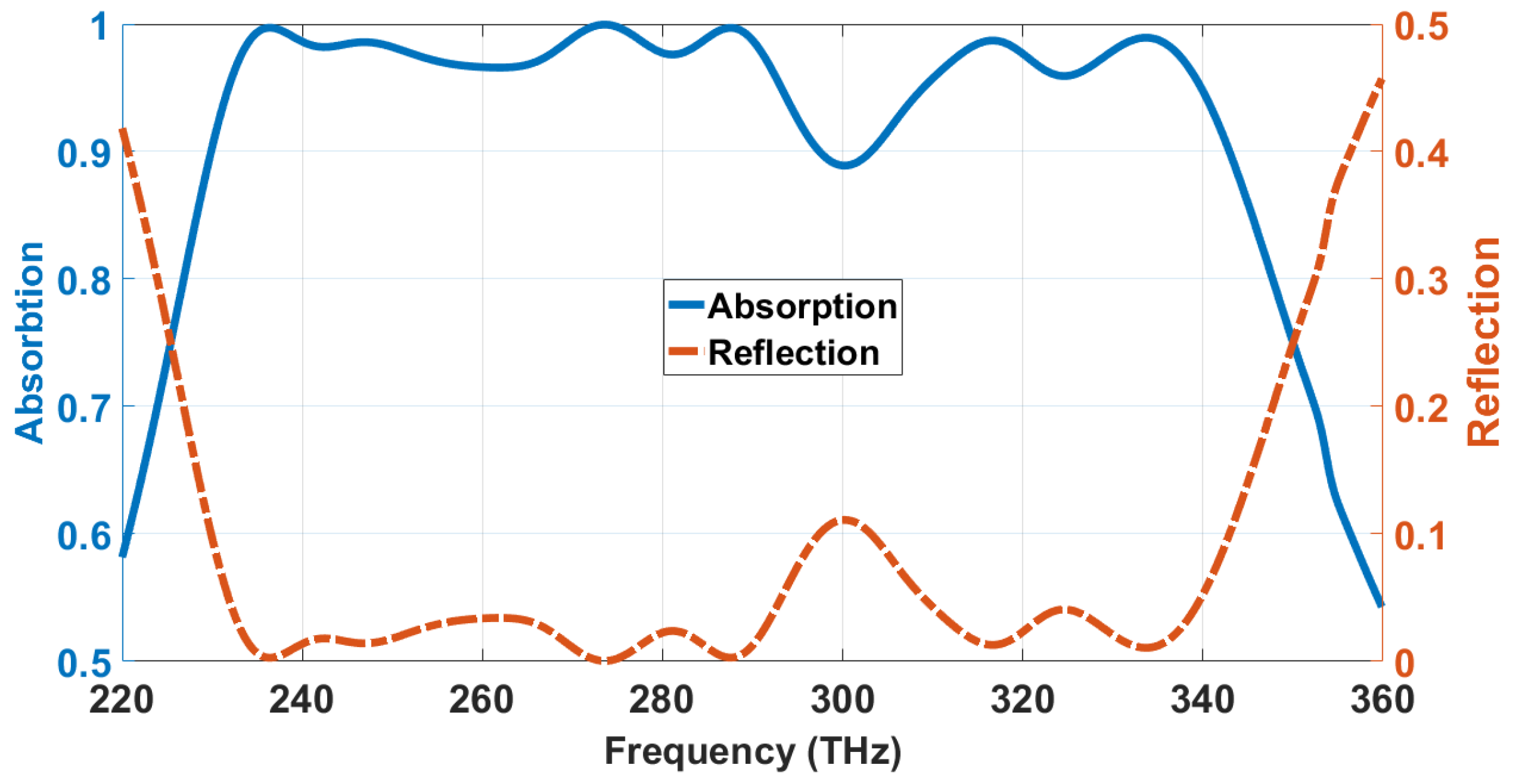
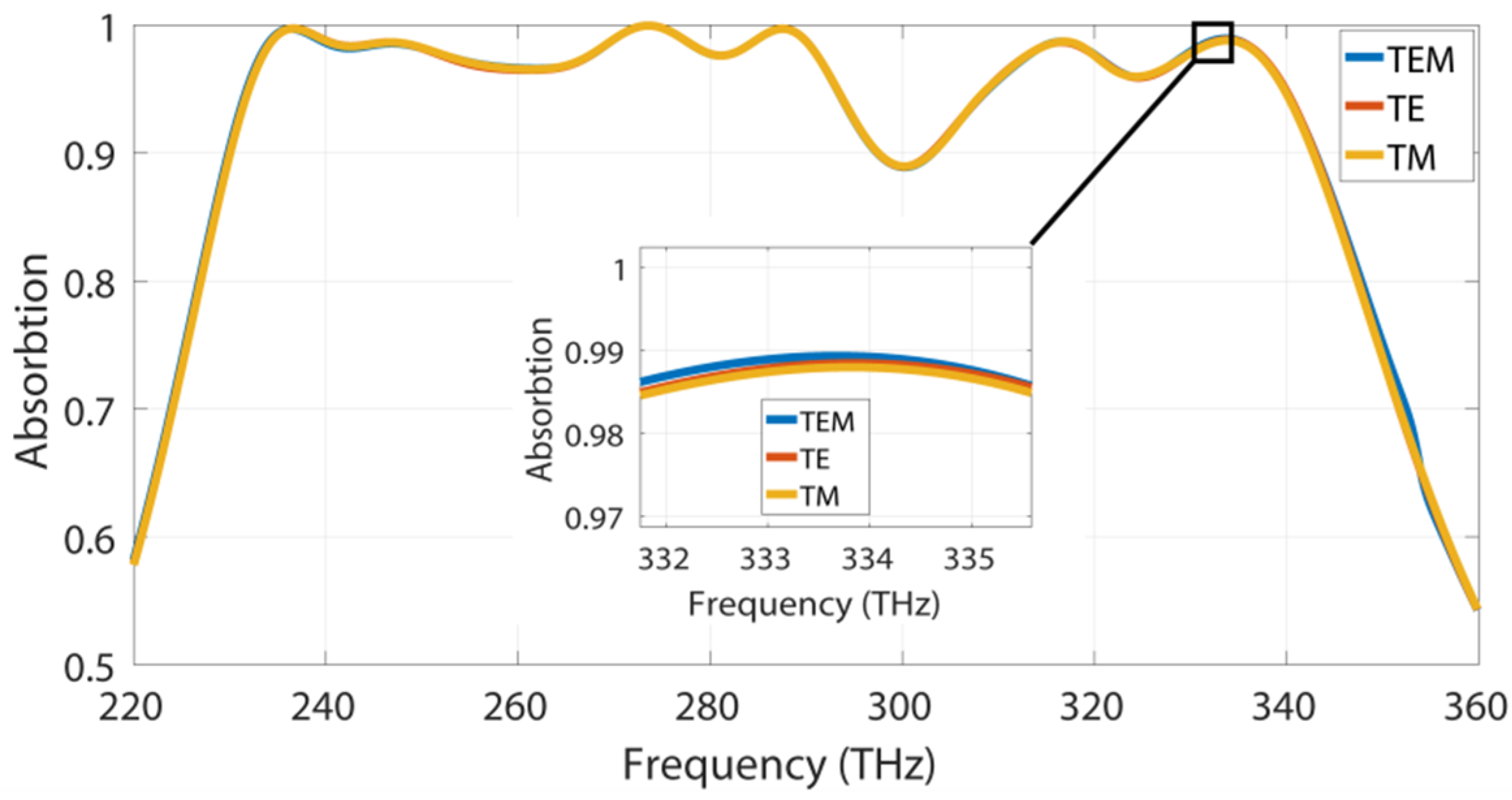

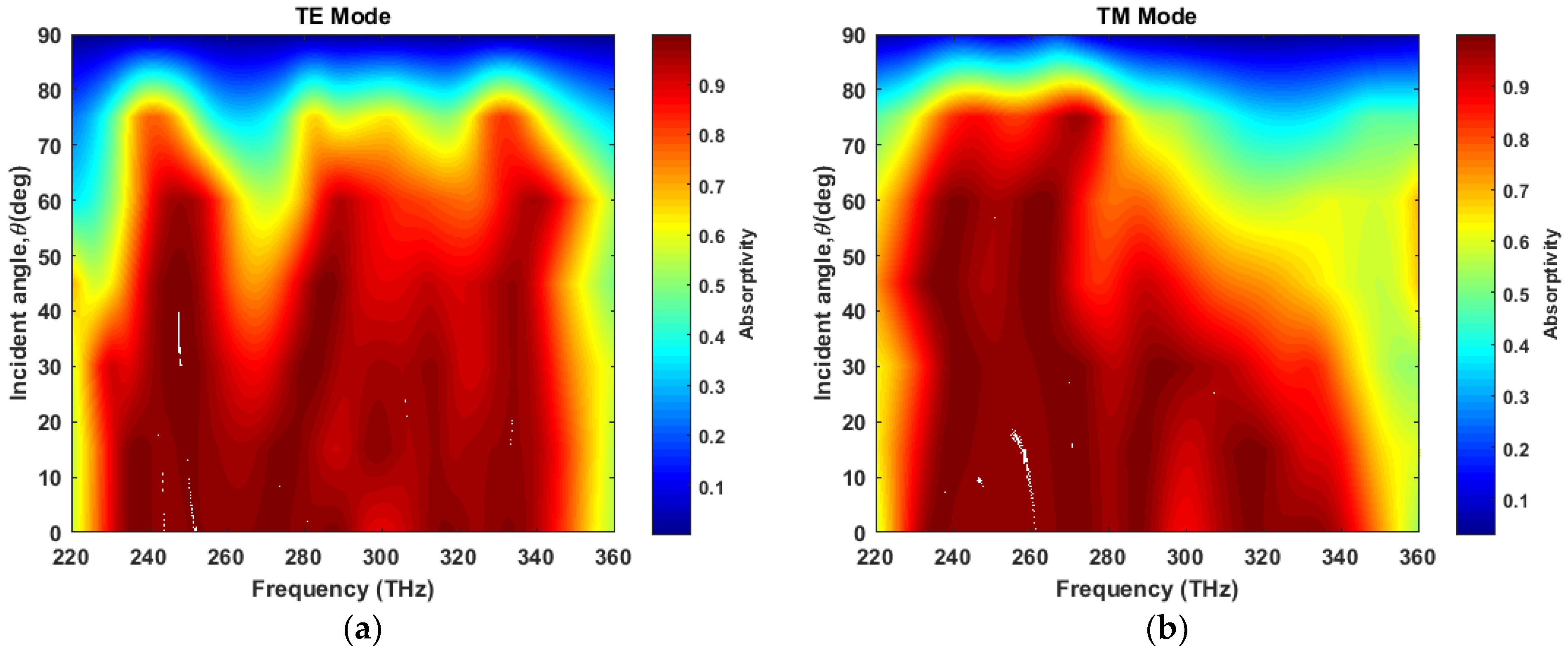

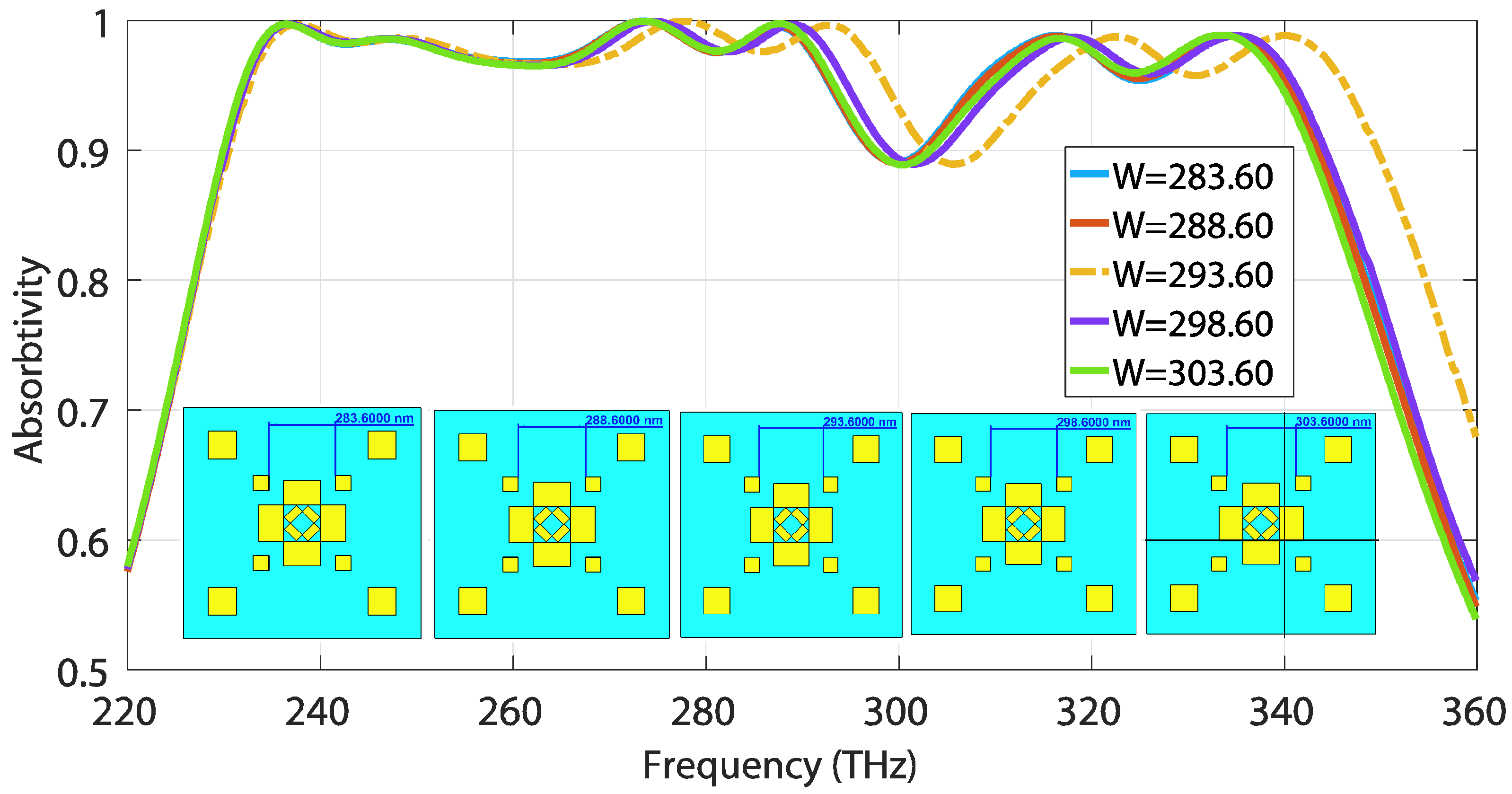

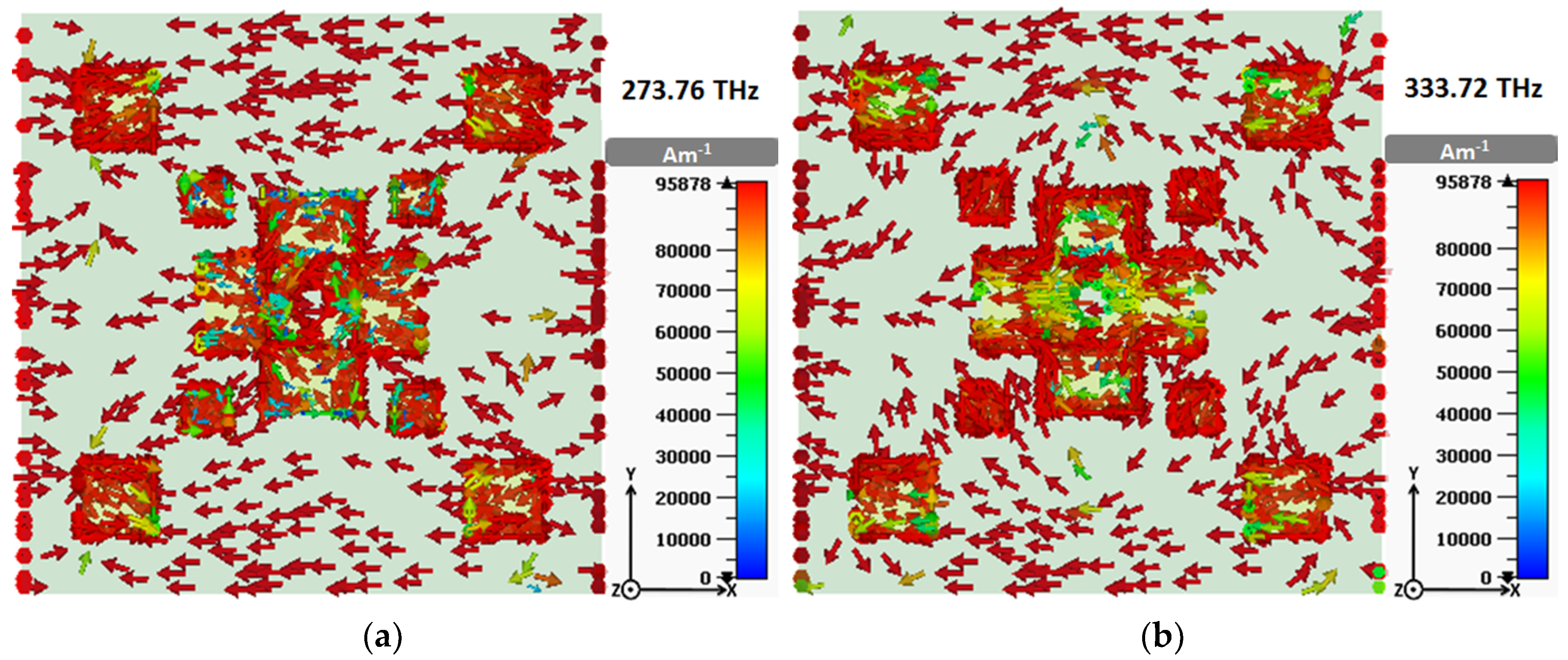

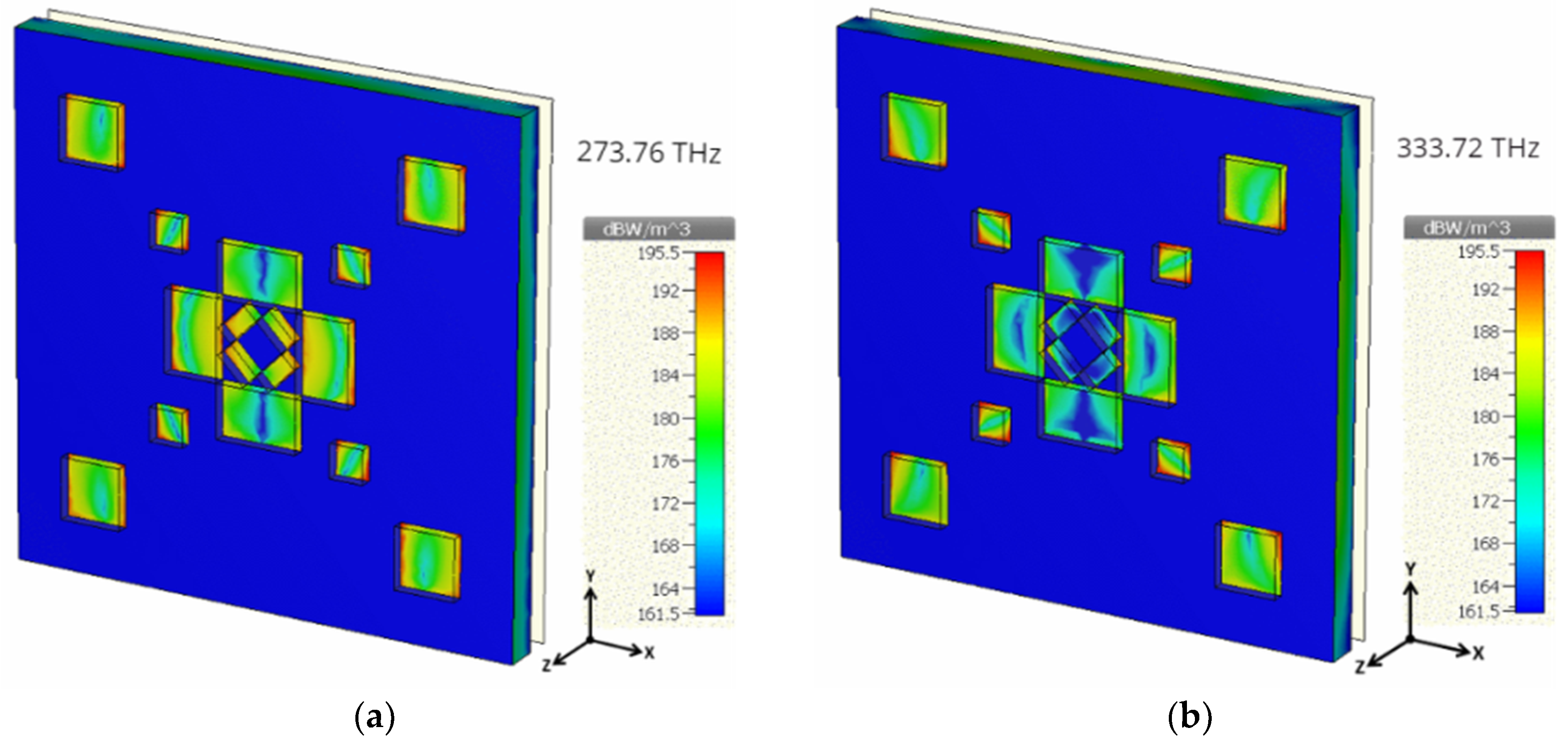
| Parameter | Value (nm) |
|---|---|
| A | 160 |
| B | 105.6 |
| C | 36.4 |
| K | 72.8 |
| E | 66.4 |
| F | 120 |
| T | 23.7 |
| P | 1010 |
| S | 72 |
| H | 50 |
| D | 66.5 |
| L | 560 |
| W | 298.6 |
| Ref. | Frequency Range THz | Fractional Bandwidth > 90% | Absolute Bandwidth THz | Material Used | Dimensionsz λ (μm) | Polarization insensitive | Angular Stability | Validation |
|---|---|---|---|---|---|---|---|---|
| [43] | 136–374 | 65.8% | 168 | Au, Ti, SiO2 | 0.27λ × 0.27λ × 0.13λ | Yes | θ < 40° | Simulated |
| [44] | 293–750 | 72.2% ( < 90%) | 331.42 ( < 90%) | Al2O3, Ge2Sb2Te, Al | 0.4λ × 0.4λ × 0.21λ | Yes | θ = 0° | Simulated |
| [45] | 330–750 | 56% | 291.46 | Mn, Al2O3 | 0.6λ × 0.6λ × 0.3λ | No | θ ≤ 20° | Measured |
| [46] | 0.1–3.0 | 187.09% | 2.9 | Cu, Si | 5λ × 5λ × 0.15λ | Yes | θ = 0° | Measured |
| [47] | 21.43–37.47 | 47.61% | 14.41 | Ti, Si | 0.27λ × 0.27λ × 0.05λ | No | θ = 0° | Simulated |
| [48] | 24.98–28.82 | 3.7% | 1.07 | In2SnO5, ZnS | 0.86λ × 0.86λ × 0.055λ | Yes | θ ≤ 50° | Measured |
| This work | 220–360 | 37.89% | 108 | Cu, GaAs | 0.77λ × 0.77λ × 0.11λ | Yes | θ ≤ 35° | Simulated |
© 2020 by the authors. Licensee MDPI, Basel, Switzerland. This article is an open access article distributed under the terms and conditions of the Creative Commons Attribution (CC BY) license (http://creativecommons.org/licenses/by/4.0/).
Share and Cite
Alam, A.; Islam, S.S.; Islam, M.H.; Almutairi, A.F.; Islam, M.T. Polarization-Independent Ultra-Wideband Metamaterial Absorber for Solar Harvesting at Infrared Regime. Materials 2020, 13, 2560. https://doi.org/10.3390/ma13112560
Alam A, Islam SS, Islam MH, Almutairi AF, Islam MT. Polarization-Independent Ultra-Wideband Metamaterial Absorber for Solar Harvesting at Infrared Regime. Materials. 2020; 13(11):2560. https://doi.org/10.3390/ma13112560
Chicago/Turabian StyleAlam, Asraful, Sikder Sunbeam Islam, Md. Hobaibul Islam, Ali F. Almutairi, and Mohammad Tariqul Islam. 2020. "Polarization-Independent Ultra-Wideband Metamaterial Absorber for Solar Harvesting at Infrared Regime" Materials 13, no. 11: 2560. https://doi.org/10.3390/ma13112560
APA StyleAlam, A., Islam, S. S., Islam, M. H., Almutairi, A. F., & Islam, M. T. (2020). Polarization-Independent Ultra-Wideband Metamaterial Absorber for Solar Harvesting at Infrared Regime. Materials, 13(11), 2560. https://doi.org/10.3390/ma13112560





